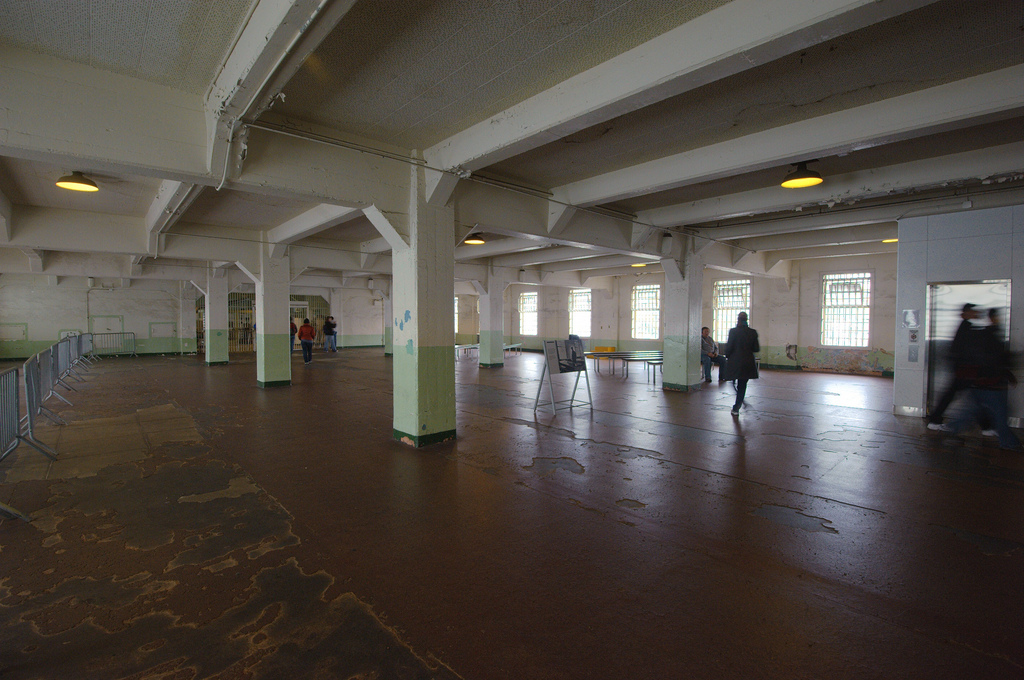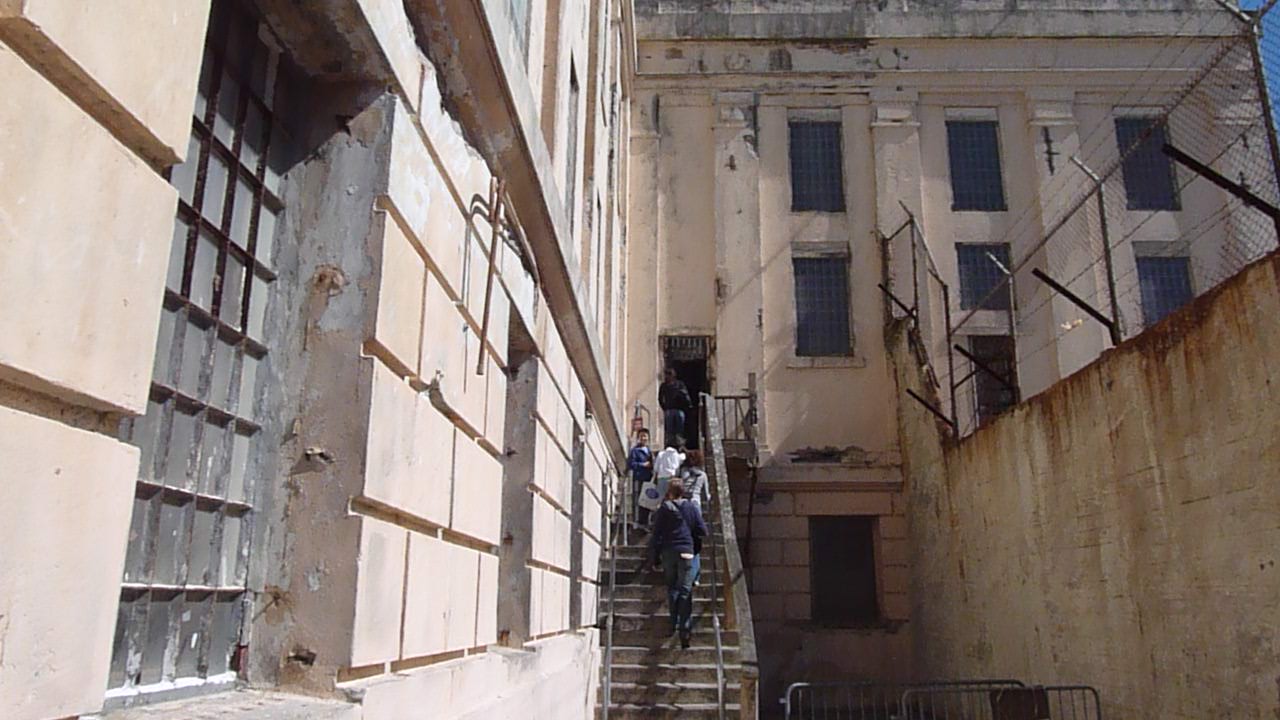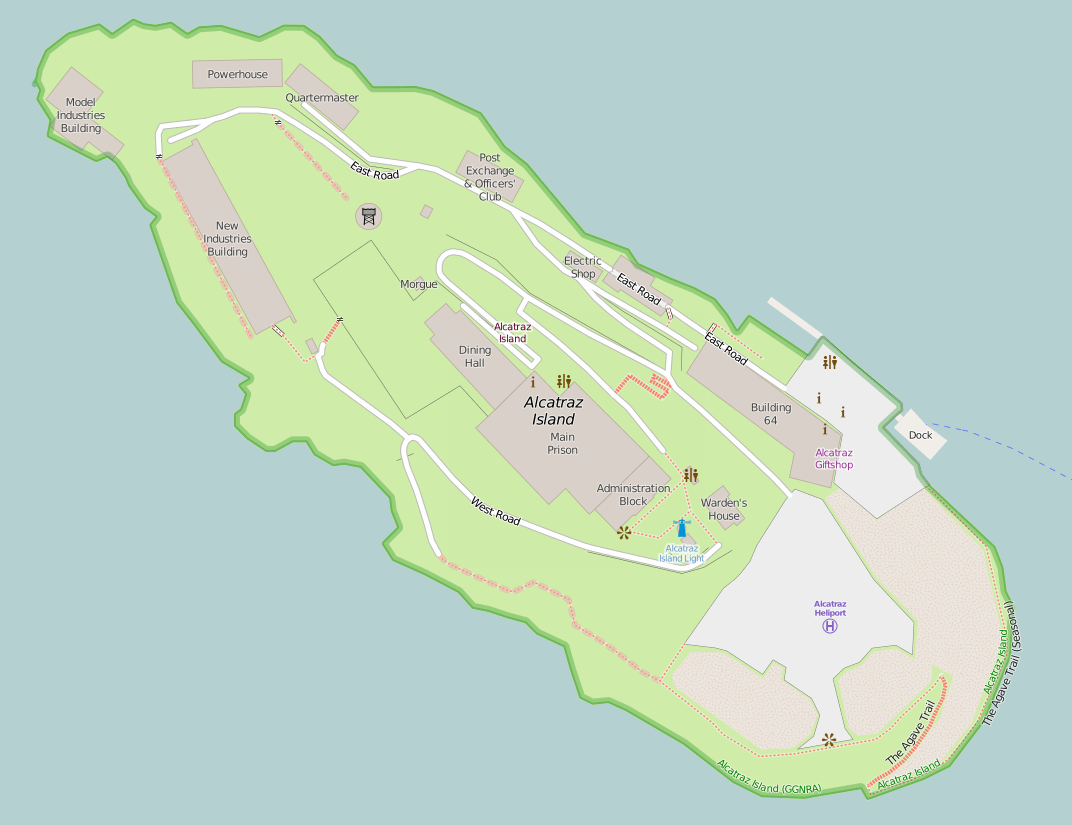Alcatraz Dining Hall on:
[Wikipedia]
[Google]
[Amazon]

 Alcatraz Dining Hall, often referred to as the Mess Hall, is the dining hall of
Alcatraz Dining Hall, often referred to as the Mess Hall, is the dining hall of
 Dining hall protocol was a scripted process, including a whistle system to indicate which block and tier of men would move into and out of the hall at any given time, who sat where, where to place hands, and when to start eating. Prisoners would be awakened at 6:30, and sent to breakfast at 6:55.
The original daily menu, established in 1934, included
Dining hall protocol was a scripted process, including a whistle system to indicate which block and tier of men would move into and out of the hall at any given time, who sat where, where to place hands, and when to start eating. Prisoners would be awakened at 6:30, and sent to breakfast at 6:55.
The original daily menu, established in 1934, included  At the end of each 20 minute meal, the forks, spoons and knives were laid out on the table and carefully counted to ensure that nothing had been taken as a potential weapon. Prisoners were forbidden from talking while eating, although many would do so discreetly; escape plans were often put forward this way. Each dining table had benches which held up to six men, although smaller tables and chairs later replaced these which seated four.
All of the prison population, including the guards and officials would dine together, thus seating over 250 people. The food served at Alcatraz was reportedly the best in the United States prison system. On the second floor was an auditorium, which was where movies were screened for the inmates at weekends.
At the end of each 20 minute meal, the forks, spoons and knives were laid out on the table and carefully counted to ensure that nothing had been taken as a potential weapon. Prisoners were forbidden from talking while eating, although many would do so discreetly; escape plans were often put forward this way. Each dining table had benches which held up to six men, although smaller tables and chairs later replaced these which seated four.
All of the prison population, including the guards and officials would dine together, thus seating over 250 people. The food served at Alcatraz was reportedly the best in the United States prison system. On the second floor was an auditorium, which was where movies were screened for the inmates at weekends.



 Alcatraz Dining Hall, often referred to as the Mess Hall, is the dining hall of
Alcatraz Dining Hall, often referred to as the Mess Hall, is the dining hall of Alcatraz Federal Penitentiary
United States Penitentiary, Alcatraz Island, also known simply as Alcatraz (, ''"the gannet"'') or the Rock, was a maximum security federal prison on Alcatraz Island, 1.25 miles (2.01 km) off the coast of San Francisco, California, United S ...
where the prisoners and staff ate their meals. It is a long wing on the west end of the Main Cellhouse of Alcatraz, situated in the center of the island. It is connected to the block by a corridor known as "Times Square", as it passes beneath a large clock approaching the entrance way to the dining hall. This wing includes the dining hall and the kitchen beyond it.
Protocol
 Dining hall protocol was a scripted process, including a whistle system to indicate which block and tier of men would move into and out of the hall at any given time, who sat where, where to place hands, and when to start eating. Prisoners would be awakened at 6:30, and sent to breakfast at 6:55.
The original daily menu, established in 1934, included
Dining hall protocol was a scripted process, including a whistle system to indicate which block and tier of men would move into and out of the hall at any given time, who sat where, where to place hands, and when to start eating. Prisoners would be awakened at 6:30, and sent to breakfast at 6:55.
The original daily menu, established in 1934, included oatmeal
Oatmeal is a preparation of oats that have been dehusked, steamed, and flattened, or a coarse flour of hulled oat grains ( groats) that have either been milled (ground), rolled, or steel-cut. Ground oats are also called white oats. Steel- ...
, milk
Milk is a white liquid food produced by the mammary glands of lactating mammals. It is the primary source of nutrition for young mammals (including breastfeeding, breastfed human infants) before they are able to digestion, digest solid food. ...
, fried bologna sausage, cottage fried potatoes, toast, oleomargarine, and coffee
Coffee is a beverage brewed from roasted, ground coffee beans. Darkly colored, bitter, and slightly acidic, coffee has a stimulating effect on humans, primarily due to its caffeine content, but decaffeinated coffee is also commercially a ...
for breakfast. Dinner
Dinner usually refers to what is in many Western cultures the biggest and most formal meal of the day. Historically, the largest meal used to be eaten around noon, midday, and called dinner. Especially among the elite, it gradually migrated to ...
contained bean soup, roast beef
Roast beef is a dish of beef that is roasted, generally served as the main dish of meal. In the Anglosphere, roast beef is one of the meats often served at Sunday lunch or dinner. Yorkshire pudding is a standard side dish. Sliced roast beef ...
, gravy
Gravy is a sauce made from the juices of meats and vegetables that run naturally during cooking and often thickened with thickeners for added texture. The gravy may be further coloured and flavoured with gravy salt (a mix of salt and caramel food ...
, string-less beans, mashed potatoes
Mashed potato or mashed potatoes (American English, American, Canadian English, Canadian, and Australian English), colloquially known as mash (British English), is a dish made by mashing boiled or steamed potatoes, usually with added milk, butt ...
, and coffee
Coffee is a beverage brewed from roasted, ground coffee beans. Darkly colored, bitter, and slightly acidic, coffee has a stimulating effect on humans, primarily due to its caffeine content, but decaffeinated coffee is also commercially a ...
. Supper
Supper is used commonly as the term for the main evening meal, although its use varies considerably. Supper may be used to describe a snack or light meal in the evening, either after or instead of dinner.
Etymology
The term is derived from th ...
was a meal that had pork and beans, cornbread
Cornbread is a quick bread made with cornmeal, associated with the cuisine of the Southern United States, with origins in Native American cuisine. It is an example of batter bread. Dumplings and pancakes made with finely ground cornmeal are st ...
, potato salad
Potato salad is a salad dish made from boiled potatoes, usually containing a dressing and a variety of other ingredients such as boiled eggs and raw vegetables. It is usually served as a side dish.
History and varieties
Potato salad is foun ...
, apricots, bread
Bread is a baked food product made from water, flour, and often yeast. It is a staple food across the world, particularly in Europe and the Middle East. Throughout recorded history and around the world, it has been an important part of many cu ...
, oleomargarine, and coffee.
A breakfast menu is still preserved on the hallway board, dated 21 March 1963. The breakfast menu included assorted dry cereals, steamed whole wheat, a scrambled egg, milk, stewed fruit, toast, bread, and butter. Lunch was served in the dining hall at 11:20, followed by a 30-minute rest in the cell, before returning to work at 12:15.
Dinner was served at 16:25 and the prisoners would then retire to their cells at 16:50 to be locked in for the night. Inmates were permitted to eat as much as they liked within 20 minutes, provided they left no waste. Waste would be reported and may make the prisoner subject to removal of privileges if they made a habit of it.
 At the end of each 20 minute meal, the forks, spoons and knives were laid out on the table and carefully counted to ensure that nothing had been taken as a potential weapon. Prisoners were forbidden from talking while eating, although many would do so discreetly; escape plans were often put forward this way. Each dining table had benches which held up to six men, although smaller tables and chairs later replaced these which seated four.
All of the prison population, including the guards and officials would dine together, thus seating over 250 people. The food served at Alcatraz was reportedly the best in the United States prison system. On the second floor was an auditorium, which was where movies were screened for the inmates at weekends.
At the end of each 20 minute meal, the forks, spoons and knives were laid out on the table and carefully counted to ensure that nothing had been taken as a potential weapon. Prisoners were forbidden from talking while eating, although many would do so discreetly; escape plans were often put forward this way. Each dining table had benches which held up to six men, although smaller tables and chairs later replaced these which seated four.
All of the prison population, including the guards and officials would dine together, thus seating over 250 people. The food served at Alcatraz was reportedly the best in the United States prison system. On the second floor was an auditorium, which was where movies were screened for the inmates at weekends.
Security
The gun gallery was situated in the Recreation Yard and mounted on one of the dining hall's exterior walls. There was a metal detector outside of the hall for security purposes. The dining hall had tear-gas canisters attached to the rafters of the ceiling which could be activated by remote control, should prisoners riot or attempt to escape. The first warden, James A. Johnston, always entered the dining hall alone and unarmed, due to heavy guarding around him. Several riots did break out in the dining hall during Alcatraz's history. Those prisoners who were not involved in the fighting hid under the dining hall tables to escape possible retribution.In popular culture
The dining hall in Alcatraz has appeared as a scene in numerous films, television programs and novels, often where criminals hatch plots to escape or crimes to commit upon escaping. It has appeared in films such asDon Siegel
Donald Siegel ( ; October 26, 1912 – April 20, 1991) was an American film director and producer.
Siegel was described by ''The New York Times'' as "a director of tough, cynical and forthright action-adventure films whose taut plots centered o ...
and Clint Eastwood
Clinton Eastwood Jr. (born May 31, 1930) is an American actor and film director. After achieving success in the Western (genre), Western TV series ''Rawhide (TV series), Rawhide'', Eastwood rose to international fame with his role as the "Ma ...
's '' Escape from Alcatraz'' (1979), and '' Naked Gun : The Final Insult'' (1994), which has a scene spoofing the dining room scenes of the 1979 film.

References
{{Alcatraz Island Alcatraz Island Prison restaurants